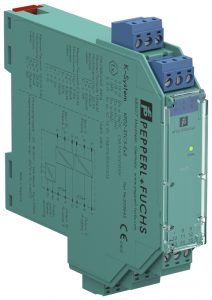Sinking and Sourcing with Smart Transmitter Power Supply for Analog Input Applications
Content of This Article
Sinking and Sourcing with Smart Transmitter Power Supply for Analog Input Applications
When selecting an intrinsic safety barrier for an analog input application, one of the biggest issues customers face is differentiating between sinking and sourcing. These terms are used to refer to where the power of the current signal is coming from. Not sure what they mean? Keep reading.
Selecting a Pepperl+Fuchs Isolator
In the past, selecting the correct device for an analog input application could be difficult. However, the new KFD2-STC5-* SMART transmitter power supply from Pepperl+Fuchs makes choosing the right device much easier.
KFD2-STC5-* series can be used for both sinking and sourcing applications. This innovative technology simplifies the process of selecting and purchasing the correct equipment for several applications. Setup is easy as no DIP switches or settings need to be adjusted to change the output from sinking to sourcing.

KFD2-STC5-Ex2 model compatible with three analog input types.
Sinking vs. Sourcing
A sinking or sourcing output refers to how the current loop is being powered. If the barrier output is sourcing, then the barrier provides the power to drive the current loop to the control system. If the barrier output is sinking, then the barrier is not providing any power to drive the current loop, and the control system would need to do so.
With the former KFD2-STC4 line, each model was only capable of either a sinking or a sourcing output. That meant users had to already know how the control system would be setup before they could select a barrier. If they ordered the wrong one, they were stuck waiting for a replacement to be shipped out to them. Now, with the new KFD2-STC5 line, each model can provide either a sinking or sourcing current output. This means the customer does not need to worry about ever ordering the wrong model.
Multiple Input Types, More Flexibility
With analog input signals, we see three main signal types: 2-wire transmitters, 3-wire transmitters, and 2-wire active current signals. While the 1-channel models of the KFD2-STC4 line were compatible with all three input types, the 2-channel model was not. This meant that either a 3-wire transmitter or an active current source was chosen as the input type was restricted to 1-channel barriers, which cost money and cabinet space. Now, the 2-channel model from the KFD2-STC5 line, model KFD2-STC5-Ex2 is also compatible with all three of these analog input types allowing users greater flexibility in how they build their systems.
Subscribe to our newsletter and receive regular news and interesting facts from the world of automation.
